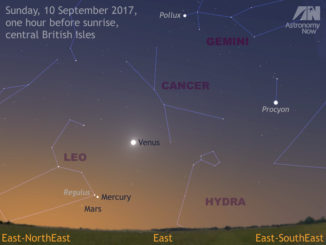The live broadcast from NASA Television of the partial solar eclipse is now over.
Related Articles

See Mercury meet Regulus and Mars near Venus an hour before sunrise
Observers in the UK and Western Europe should find an observing location offering an unobscured eastern horizon an hour before sunrise on Sunday, 10 September to see innermost planet Mercury just 0.6 degrees from Regulus, the brightest star in Leo. Conspicuous planet Venus is your convenient celestial guide to finding Regulus, Mercury and Mars.

See the Moon hide bright star Aldebaran on New Year’s Eve
Observers in the UK with clear skies on the night of 30—31 December 2017 can see the 12-day-old waxing gibbous Moon glide through the Hyades cluster in Taurus, occulting a number of naked-eye stars along the way, culminating in the disappearance and reappearance of first-magnitude star Aldebaran in the small hours of New Year’s Eve.

See the Moon and Jupiter get close on 7 May
Observers with a clear sky to the south as darkness falls on Sunday 7 May can see the 12-day-old waxing gibbous Moon and planet Jupiter separated by little more than twice the width of a full Moon. For telescope owners in the UK, this is a night where you can also see Jupiter’s Great Red Spot and the planet’s four large Galilean moons.
